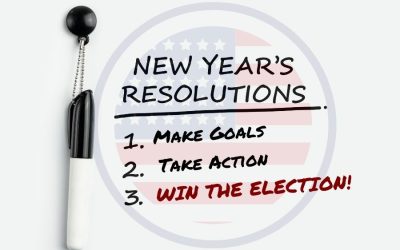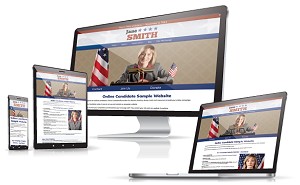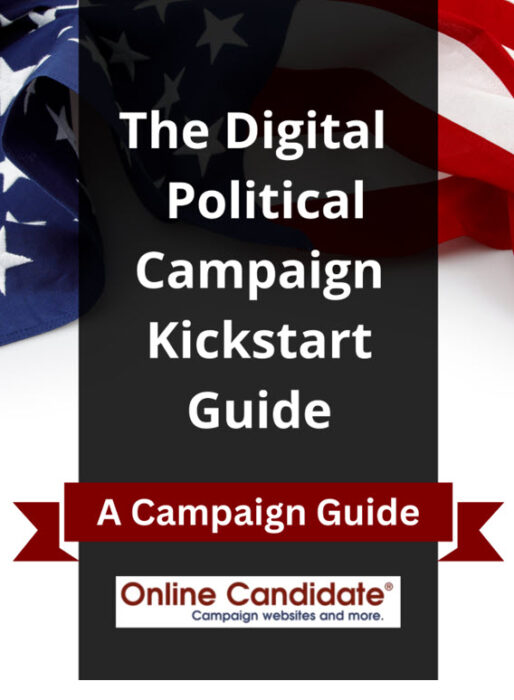Read Our Interview on WebsitePlanet.com
For those who are interested in the backstory of Online Candidate, check out our interview on WebsitePlanet.com.
Please describe the story behind the company: What sparked the idea, and how has it evolved so far?
A friend of ours ran for office way back in 2003. She was an underdog in the campaign and needed all the help she could get. We thought the best way to help was to build her a campaign website. This was back before having an online presence was a large part of political campaigning and fundraising.
The site was successful and had a large impact on the campaign. It helped raise issue awareness on local development and many of the back-room deals being made without public knowledge or input. We managed to get our website to show for searches on our opponent’s name. We also managed to get unflattering articles about the opponent to appear, as well. This was due to linking out to those articles from the site to influence rankings. (Today this would be called ‘Google Bombing’.)
The campaign promoted the website on signage and in local newspaper ads. This bad publicity spooked the opponent and led him to spend a lot of money on a competing site.
In the end, our candidate won the election.
Keep Your Campaign Material Original – And Avoid the Consequences
Here’s a reminder to make sure that you have the proper rights and permission for anything you use for your political campaign. The Internet makes it easy to lift language or text from other sources without attribution – and makes it just as easy to be discovered.
 Whether you are running for local office or aspiring to a higher position, copying material without attribution can get you into trouble. A number of previous US presidential candidates have dealt with accusations of plagiarism, including Rand Paul and Scott Walker.
Whether you are running for local office or aspiring to a higher position, copying material without attribution can get you into trouble. A number of previous US presidential candidates have dealt with accusations of plagiarism, including Rand Paul and Scott Walker.
The issue can become a distraction, forcing a campaign to defend itself and throwing it off-message.
Sometimes, it can cost a candidate the election.
When Lt. Gov. John Walsh was appointed as interim senator for Sen. Max Baucus in 2014, it was discovered that Walsh’s master’s thesis from the United States Army War College had been partially plagiarized. The scandal eventually led to him dropping out of the race.
Even Joe Biden has had his share of plagiarism issues. While running for president in 1987, Senator Biden was accused of lifting lines from a speech by a British Labour Party leader. Later that year he was accused of lifting content from other speeches, including a speech from former President John Kennedy. It was also reported that Biden was forced to retake a class at the Syracuse University College of Law in 1965 after using law review material without attribution.
The Senator wound up as US Vice President under Barack Obama and, eventually, President.
It’s not just copy that can be swiped. Even graphic designers can get you into trouble.
Take this story from a few years back as an example of how swiping a design can draw all the wrong attention.
Oregon candidate pulls look-alike logo
Libertarian Senate candidate Mark Delphine’s campaign site featured a logo showing an American flag wrapped around a star to form a D-shape, similar to the Blue Jackets logo which shows the flag of Ohio wrapped around a star in the opposite direction. Read more…
Here is the logo in question. The design was donated to the campaign.
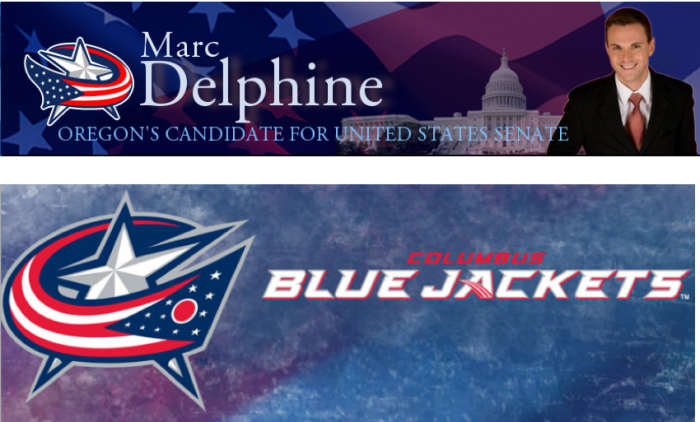
What do you think? Are they similar?
Free or paid, all campaign material should either be original, licensed or used with explicit permission. This applies not only to graphics, but also to all content, including photographs and slogans.
Taking liberties with your campaign print material
When putting together your political campaign brochures, political website, or other material, it’s important to keep some guidelines in place. While some candidates create all their own material, other campaigns outsource the work or leave it to members of the campaign staff. No matter who does the work, there are some things to keep in mind that will help keep you out of trouble.
Here are a few things to watch out for:
Use only your own or licensed images and photos
Be careful with the images you use in your brochures, palm cards or any other print material. The best images are those that are taken by the candidate or campaign. Be sure to obtain prior permission from any copyright owner if you use such material in your campaign brochures. If you use a designer, be sure that they obtain proper permission for any images or design elements they incorporate into your brochures.
Photographers who infringe may be required to compensate for economic loss. From a legal standpoint, most lawsuits are filed against the person who uses a photograph rather than against the photographer.
In some cases, even using a logo or state flag can be a violation of election rules.
Don’t feature other people or places without permission
Be sure that anyone that is displayed or photographed in your campaign literature has been notified and given permission. Just because you had your picture taken with members of a local organization does not mean they will appreciate appearing in a political advertisement. Even for ‘friendly’ individuals or groups, never assume permission – always ask for it.
Don’t lift copy without acknowledging sources
Be careful not to have your writers lift, even inadvertently, copy or text from other sources without attribution. Taking liberties by plagiarizing material can prove embarrassing if discovered. Worse case, you could get into legal trouble. When in doubt, cite your sources.
Use proper disclosures where required
State or federal law may require specific disclosures for your campaign communication. Disclaimers for political campaign advertising are required by federal or state law in order to protect the public from false and misleading information. They may include the name of the person or organization that paid for, authorized, solicited, directed, supervised, or had responsibility for preparing the advertisement.
The use of plagiarism in political campaigns can be seen as a form of fraud. Any time you use someone else’s work, you are essentially cheating. In the context of a political campaign, it is an unethical and dishonest practice. Not only can it tarnish the candidate’s image, but it reflects on the candidate’s ability to perform well in their current or future elected positions.
Running for office? Our Regular and Enhanced Political Website Packages include a custom-designed header, logo and color design – and we provide high-res version of your logo or header on request – for FREE.
Overcoming Online Fundraising Naysayers
Even years after digital campaigning has become mainstream, we still hear about some pushback that local candidates get for wanting to fundraise online. The argument is often made by a team member believing that the costs to fundraise online are too high.
In other words, because an online fundraising method incurs fees, then it should be avoided.
By that logic, you shouldn’t solicit donations by mail, either. After all, stamps and envelopes cost money.
And don’t take credit cards, either – they charge a fee off the top!
Forget holding a campaign events. That can cost plenty of money up front, without even a guarantee of covering expenses.
And who wouldn’t rather take the time to write a check and mail it over making a quick online donation?
When it comes down to it, a person’s negativity to fundraising through alternate ways is usually due to fear. They are afraid that it’s too complicated to take money through online sources.
They couldn’t be more wrong. It’s easier than ever for political campaigns to raise money online. It’s the first place many candidates turn to when they are just starting out.
Why online fundraising in important to political campaigns
Online fundraising services are a great way to raise money for your cause. The best of these services offer intuitive interfaces that make creating and managing events, donations, and pledges a breeze. To start, you’ll need to pick an online donation service. When you sign up, you’ll need to provide information about your organization and bank account information to accept deposits.
It usually takes a few days for your information to be verified. Once that’s done, you’ll be able to get started. It’s pretty simple to incorporate a donation form into a website. For example, with our own campaign website platform, online fundraising systems are easy to set up as an embedded form or a direct link from your website. We are always glad to help our clients with integration.
Sure, taking money online costs a bit in transaction fees, which range around 4%, plus .30 or so per transaction. But those fees come from money that your campaign probably would not have raised otherwise through email and social media. Not only that, but digital donation platforms make reporting compliance a LOT easier than dealing with loose checks.
So, the next time someone in your campaign goes negative about online fundraising, tell them that they have nothing to fear – and everything to gain – by taking donations over the web. It’s easier than you think!
Online Candidate websites can be integrated with Raise the Money, Anedot, ActBlue, and other online fundraising services. Learn more about our affordable political website packages.
8 New Years Resolutions for Political Candidates
There are many New Year’s resolutions that people make, but few people follow through with them. If you are running for office this year, here are some resolutions you’ll want to keep.
- Put together a solid political campaign plan. Today’s political landscape is more complex than ever before. There are many tasks required in preparing and executing a political campaign. A political campaign plan is a comprehensive document that outlines all the facets of a campaign. It includes what needs to be done, who will do it, and by when. It’s the outline of your overall campaign strategy. In addition to this outline, a calendar should be created to monitor upcoming events and assign deadlines for each task.
- Do your research. Research the problems facing your community. Attend local and organizational meetings. Speak with local and civic leaders for perspective. Get to know your opponent’s strengths and weaknesses. Follow what the opposition is doing for activities, advertising, and messaging. The campaign trail is tough enough. Do what you can to avoid surprises.
- Find out what your local voters care about and what they want for their future. It’s not enough to run just based on what you care about. Consider what your community cares about. You may not agree with everyone’s views, but that doesn’t mean you can’t learn from them when developing your own platform.
- Focus on increasing donations from those who are willing to support your cause. The goal is to galvanize the supporters and ensure that you generate enough funds to get your message out. If you followed the previous resolutions, you’ll have an idea of what issues are important to various segments of your electorate. Use that information to send personalized ads, emails, texts, and even letters with a specific request for their help.
- Don’t discount volunteers. Even though donations are important, a helping hand can be just as important, if not more. Try to attract volunteers whose skills and expertise can help your campaign. Even a volunteer who can only put in a few hours of time can be invaluable. Make sure you have a volunteer coordinator who can effectively put good people to use.
- Plan to speak with as many voters as possible, online and offline. It is crucial for candidates to reach as many voters as they can to get them engaged and excited about the campaign. While in-person outreach may be limited due to the ongoing pandemic, online means such as social media and holding online events can help you develop two-way communication.
- Get some good photography. Having worked on campaign sites for over fifteen years, one of the biggest weaknesses that many candidates face when putting together a digital presence is poor images. Take the time and resolve yourself to invest in great campaign photos.
- Try something new online. Digital campaigning has rapidly evolved over the last few years. While political websites and social media accounts are standard these days, why not push things a little? Try running a Facebook Live event, starting a YouTube channel, or perhaps interacting on a forum like Reddit. Tip: Always try and test new formats so you know how they work before jumping into them on a campaign level.
Did you know that 85% of American adults now report that they go online every day? According to a 2021 Pew Research Center survey, 31% of Americans say they are online ‘almost constantly’.
Political resolutions are not just about following through on campaign promises; they’re also about convincing voters to support your candidacy.
Make this year your best ever!
Creating a Facebook Page for Your Political Campaign
Planning on setting up a political campaign Facebook page? For new and experienced politicians, Facebook provides a powerful way to connect with and engage with supporters and voters.
For some political candidates, social media is a whole new world. They may not be aware of the the potential benefits for politicians running for office. With 69% of US adults using Facebook, it’s a great way to promote a political campaign or cause.
Below are Facebook tips and best practices for political campaigns. We also cover how to become authorized for Facebook advertising.
How to use Facebook for your campaign:
- Create a political campaign Facebook page
- Name your page properly
- Update your profile
- Add a cover image and profile picture
- Authorize your organization for Facebook advertising
- Track your website traffic
- Strategy: Be authentic in your posts and updates
- Budget to advertise and promote your campaign page
- Use Insights to learn more about your audience
- Create Groups for your supporters
- Communicate through Facebook Live
- FAQs
Download our FREE Campaign Guide
Setting up a campaign Facebook page
Before you create a political Facebook page, it’s a good idea to familiarize yourself with how Facebook (now under the corporate name Meta) works. You can do this by creating a personal account and building a network of friends and acquaintances.
Then, when it comes time to create social media accounts for your campaign, you can ask your personal connections to become your campaign’s first social media followers.
Any politician can create an official Facebook page. However, Facebook only allows you to create a page if you are the candidate or an authorized person on that politician’s staff. Fake pages are removed, and users who create unauthorized pages may have their accounts disabled.
Unlike a personal profile, Facebook campaign pages are visible to everyone on the Internet by default.
Pro Tip: Don’t use your personal Facebook profile for campaigning. It has limited reach, and doing so is against Facebook’s terms of service. Instead, set up a public page for your campaign. If you already have a government Facebook presence, you should keep that page separate from campaign activity. Some jurisdictions have specific laws covering political activity on Facebook or Instagram.
Here are the steps for building a candidate Facebook page:
- Go to Facebook.com and log in. Click the ‘create a page’ link.
- Click the “Community or Public Figure” template.
- In the next screen, name your page and type “Politician” or “Political Organization” under category.
- Agree to the terms and get started.
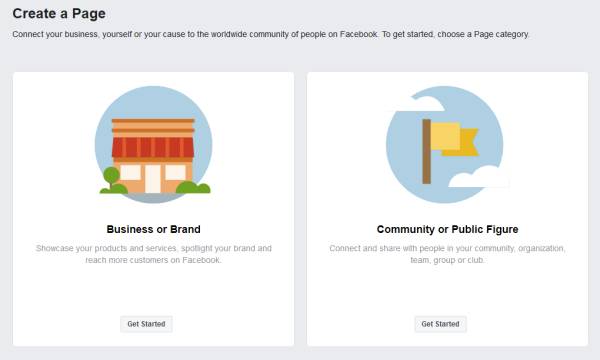
If the page is for a candidate, choose ‘Political Candidate’ as the category for your page.
After you create your campaign Facebook page, share it. Any person on Facebook can connect with your page by “liking” it. In doing so, they will receive future updates about the Page in their feed and will be able to comment and interact on the Page.
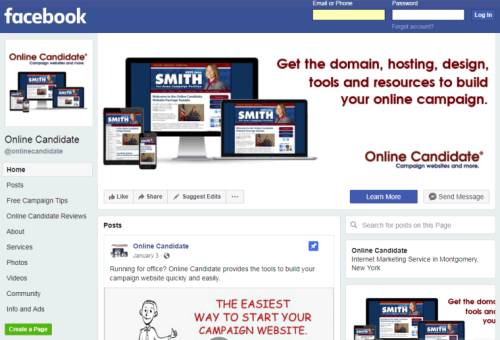
Share your campaign page with friends and ask them to like and share it.
Choose the right name for your page
When a page gets a certain number of “likes,” you can create a vanity name or vanity URL for your page. You may want to just stick with “vote for” or “elect” with your name. Or just use your name. Keep it simple. You may want to avoid using the position you are running for in the page name or shortcut. The name may become invalid if you run for a different position in the future.
Vanity names are unique, so if you choose the candidate’s name, you may find that another page already shares the name. You may want to include the word “vote” or “elect.” Right now, you can only change the name of a page once. Any submitted name change requires Facebook approval.
Update your Facebook profile
Once you have created your page, you’ll want to fill out the following information.
- First, you can add a profile picture to your new page. For a candidate, that will typically be a nice headshot. For the cover photo, you can use your campaign logo alone or a custom image that perhaps includes a local landmark or a photo of the candidate in action. You’ll still want to include your logo in the image somewhere.
- Under “Edit Page Info,” there are two important sections to fill in, General and Contact. In the General section, add a brief bio about yourself and choose your category. This category will probably be “politician, political candidate, or political organization.”
- Along with your contact information, add your website link and any related social media platforms. These links are important, as they help tie all the elements of your online presence together.
- These links are important, as they help tie all the elements of your online presence together.
Once you have your page set up, you can add additional tabs for video, discussion, photos, and more.
Tip: Be sure to link back to your campaign website and other social media accounts. These are valuable links that will help tie together your online presence for search results.
Add a cover image and profile picture

Facebook lets you choose your own “cover photo,” which is positioned at the top of your timeline. Your cover photo will be the first thing a user sees, so it should really make a good impression. Design your political Facebook cover to match the look and feel of your other promotional material.
The profile picture appears to the left of your cover image. You can use an existing photo that you uploaded to Facebook, or you may upload a new image. You may want to make your profile picture a candidate headshot or campaign logo.
Keep in mind that old profile pictures are archived and not replaced, so keep them professional.
Get your campaign authorized
Before using Facebook for political campaigns, the site requires authorization. Facebook (along with X/Twitter and Google) have implemented account verification measures to provide greater transparency and to curb outside influence over elections.
Users who want to buy political ads must verify their mailing address. Generally, any ads that mention a political candidate, issue or cause must adhere to these rules. It’s a broad definition of what falls under these rules. You may find your content getting flagged regardless of how political you think your ad may or may not be.
Ads that qualify will have a “paid for by” tag and will be placed in a public political ad archive. Anyone, including your opponents, can search for this information.
Requirements to run Facebook ads:
- Be the Page admin or advertiser on the Page from which you’re running ads.
- Have two-factor authentication enabled.
- A US passport, driver’s license or ID card
- A US-based residential mailing address
Facebook’s authorization process for political advertising plays a key role in maintaining transparency. It requires advertisers to verify their identity and location. This step ensures that only legitimate entities can run political ads. The process involves submitting government-issued IDs and a mailing address. Facebook then sends a verification code by mail to confirm the address. So start the process early!
Related: Facebook Ad Authorization For Your Political Campaign
TIP: Verify your social media accounts early, as it may take time to get the postcard and final approval and authorization. This process can take a few weeks!
Track your website traffic and advertising effectiveness
Measuring the ROI of Facebook advertising in political campaigns involves tracking specific metrics. These include engagement rates, click-through rates, and conversion rates. Campaigns should set clear objectives for their ads. Objectives can range from increasing page likes to driving traffic to a donation page. Campaigns can measure how well ad performed by comparing the outcomes to the cost. Analyzing which ads perform best helps refine future advertising efforts.
The Facebook Pixel is a small amount of tracking code that can be used to create an audience of people who visit your website. It is also a way to track conversions. For example, if you run Facebook ads that send visitors to your donation page, you’ll be able to tell which political ads converted. This will improve your ability to fundraise.
Setting up a pixel is fairly straightforward. Once you get the code, you add it to your website.
Facebook Strategy: Be authentic
Voters value authenticity from politicians who use social media. Candidates should work to engage in a conversation with readers, rather than simply broadcasting campaign updates. It is, after all, a social network. Treat it like an ongoing conversation. Read the comments, respond when necessary, and take note of what your supporters (and your dissidents) are saying.
When possible, the candidate should be the one who posts, and the messages should be authentic. Don’t just post a string of press releases.
The goal is to get voters to know, like, and trust you. If every post appears to have gone through a legal review by a PR firm, that won’t happen.

Social media is not a one-way channel.
TIP: Facebook updates can include updates from your campaign website, press releases, news articles, event reminders, photographs, personal observations, and more.
If you are not sure what to do as far as posting updates or what to promote, follow the examples and strategies of other popular candidates.
Budget to advertise and promote your political campaign
Don’t count on ‘Likes’ to make your posts go viral or attract new followers. Facebook today is fully ‘pay to play’, meaning that even your followers won’t see many of your posts unless you pay to promote them. If you want to reach others within the Facebook platform, you will need to spend money on advertising.
There are a number of different Facebook ad types, including video ads. You can run ongoing ads or promote specific posts. Facebook ads tend to be inexpensive. They cost a fraction of what other online marketing channels cost. It’s a cost-effective way to add credibility and amplify your message. They are also a great way to ask for donations and support.
One of the greatest advantages of Facebook advertising is that you can target users (or voters) with granularity. You can target ad recipients by behaviors, interests, demographics, age ranges and locations. If you are targeting voters in your location, you will want to at least target by location and voting age. If there is a particular issue that you are running an ad for, you can target your audience by interest.
In addition to segmenting, your Facebook ads should have visuals that attract interest. Images with faces tend to attract more attention than just text. You should also include a clear call to action in your ads.
What political Facebook advertising is allowed today?
Don’t rely solely on “likes” to amplify your posts or gain new followers. The landscape of Facebook has evolved into a pay-to-play arena. This means most of your posts may not reach your followers unless you invest in promoting them. To extend your reach on Facebook, allocating a budget for advertising is essential.
For the latest information on Facebook political ad requirements, visit https://www.facebook.com/business/help/167836590566506
Related: How Much Should Your Campaign Budget For Digital?
Use Insights to learn about your audience
Check your page’s ‘Insights’ tab often. It provides a large amount of valuable data. In addition to tracking traffic, you can also see demographic data, the number of people reached through your posts, interactions with your posts and even insights such as the best times to post.
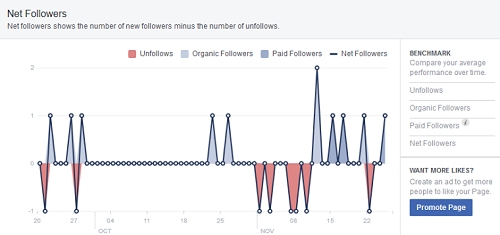
Create Groups for your supporters
Create groups to help you quickly communicate, galvanize support, and encourage action on behalf of your cause. Campaigning on Facebook takes ongoing effort. It’s not a ‘set and forget’ promotional system.
Communicate through Facebook Live
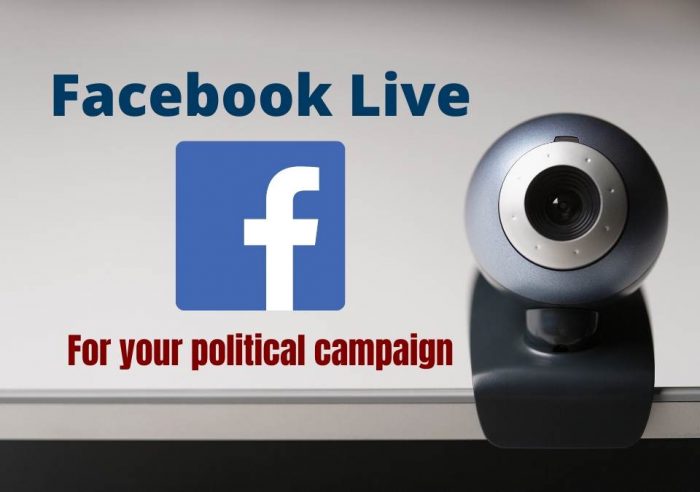
Facebook Live is a feature that allows candidates to video directly to an audience through Facebook. You can send video through your Facebook profile, a page, a group, or even an event.
Many candidates today use Facebook Live and Instagram to record and stream video. What makes it convenient is that you don’t need a full studio setup. However, you should invest in a decent microphone for better sound quality.
More Information: Using Facebook Live for Your Political Campaign
Don’t be a jerk – even if others are
 Be yourself. Share your opinions, your personality, and even a bit of your daily life. Consider what voters might want to know or have an interest in. Post frequently, but not so often that you appear to have nothing better to do. Try not to be overly negative or encourage negative posts from others.
Be yourself. Share your opinions, your personality, and even a bit of your daily life. Consider what voters might want to know or have an interest in. Post frequently, but not so often that you appear to have nothing better to do. Try not to be overly negative or encourage negative posts from others.
Smearing opponents might win you points with your supporters, but it may turn off others who are unsure about you. Most voters will never meet you in person. If you are a jerk online, they will only assume that you are a jerk in real life.
Faqs
What are the specific strategies for engaging undecided voters on Facebook?
Engaging undecided voters on Facebook requires a tailored approach. Campaigns should focus on creating content that addresses common questions or concerns. Sharing testimonials from other undecided voters who have been persuaded can be effective. It’s also beneficial to host Q&A sessions. These sessions allow candidates to directly address voters’ concerns. Engaging content that highlights the candidate’s policies and values can sway undecided voters.
How can political campaigns navigate Facebook’s changing algorithms and policies to maintain visibility?
Navigating Facebook’s changing algorithms and policies can be tough, as they change constantly. Campaigns should stay updated on Facebook’s guidelines for political advertising. This can be done by regularly checking Facebook’s official communications and attending webinars or trainings offered by Facebook. Posting diverse content such as videos, live streams, and interactive posts, can help maintain visibility. Engaging with followers through comments and messages keeps the page active. Adapting to changes quickly ensures a campaign’s message continues to reach its audience effectively.
You can set up your Facebook page – or have us do it for you!
You now understand how to create and promote a Facebook page. Online Candidate offers a Site Launch and Social Media Setup service. We create your political Facebook page and Twitter profiles. This includes designing a Facebook cover image and Twitter account background. Many of our candidates use this service in addition to our political web design services.
Related:
What To Do With Your Campaign Website After The Election
The election is over. As a candidate, you’ve either won or lost. All the advertising has ended, the final bills are paid, and the signage comes down. But don’t forget the campaign website – it’s still out there! Here are some ideas for dealing with your website after Election Day.
Make a final update
No matter what you do, you should post a final election update to your website. Won or lost, your home page should acknowledge the results. Thank your friends and supporters for their help – they deserve it.
If you have a domain name that is year based (electsmith2020.com), you should keep the website up for a few months, or until the end of your hosting period. You site may still get traffic from those interested in the outcome of the election or what is happening with the candidate. With a date-based name, odds are you won’t use that same name/website again.
If you have a name that is position or name based (smithforsupervisor.com or joesmith.com), consider the long-term benefits of keeping the site active until the next campaign vs shutting the site down completely. Even if you have a domain name that is date-specific, you can still keep your existing website, but just change the site’s domain name. (We can do that for you.)
Keep the campaign alive
To keep volunteers and fundraisers available and in the loop, elected officials and PACs should never truly shut down their campaign organizations. You may want to shut down certain pages or sections of the campaign website, but continue to run the site with relevant news and event updates. In other words, if you are planning on running again, use the site to keep the interest alive until the next campaign.
Keeping the site active also gives you a head start when it comes to fundraising for the next campaign. Having supporters already in the loop will make it easier to get them involved again when you need their help.
Convert the site
If you are done with politics altogether, your website can always be redesigned and re-purposed for another use, such as an organization or personal site. If you run a business in your name, you can either switch the entire site over or point the domain to another site.
If you like the Online Candidate content management system, we can convert your site to a business website with a new domain name. Contact us for more information.
Redirect your domain name
Instead of having the domain name point to your campaign website, you can have the name point to another website or web page. Depending on the elected position, your newly-won office may already have an official web page waiting for you. Use the traffic that would have gone to your old website and send it there.
Shut down the site completely
For many Online Candidate clients, this seems to be a common – and unfortunate – end to their websites. When the hosting period ends, they don’t bother to renew and let the domain name lapse.
There are a few downsides to completely shutting down a campaign website and letting the domain name go:
- Someone else can pick up the domain name, and you’ll probably have a tough time getting it back.
- You’ll have no control over a new website that someone creates with your lapsed domain name.
- All the links that you built up over the last campaign will now go nowhere. There’s no guarantee that those links will still exist the next time you revive your website (assuming that you have not let your domain name lapse in the meantime).
Even if you want to completely shut everything down, we suggest that you at least keep your domain name active – especially if it matches the candidate’s name. Keeping a domain name registered is a nominal cost, and it keeps the name in your possession.
Want to convert to a business website? You have a number of options for your website and domain name. If you have any questions about keeping or converting your existing site, feel free to contact us.




